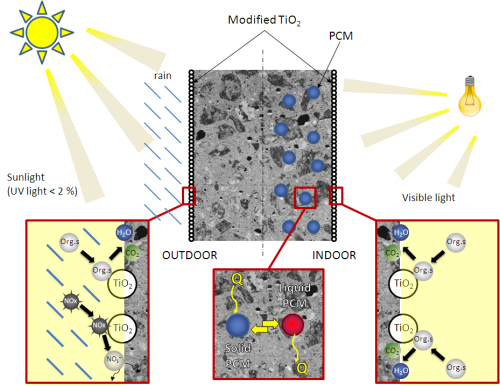Project - Photocatalytic and energy – Storage innovative concretes (PhoEnICs) - Marie Curie Reintegration Grant
Project start September 2010. Project terminated with effect from February 2012 and continued as FP7 Project called Light2CAT.
Within the European Union, buildings account for 40 % of total energy consumption and a third of CO2 emissions (Directive 2010/31/EU). In the effort of tackling climate change by reducing carbon footprints and saving resources, reduction of energy consumption in buildings is a paramount objective to target. Furthermore, it has been demonstrated that climate change highly depends on air pollution too (J. H. Seinfeld, Atmospheric chemistry and physics: from air pollution to climate change, 1 edn., Wiley, New York, 1998), hence the need to improve air quality in European Countries has been identified as a major requirement to be achieved within the next decade (Directive 2008/50/EC).
Photocatalytic concretes, i.e. concretes with exposed surfaces modified with TiO2 photocatalysts, have shown ability to reduce air pollution mainly caused by nitrogen oxides (NOx), sulphur oxides (SOx) and volatile organic compounds (VOCs) as well as providing self cleaning effect through the light induced super-hydrophilic nature of light irradiated TiO2 surfaces and ability to degrade compounds causing dirt and stains.
In this project highly visible light active TiO2 photocatalysts are implemented into concrete in order to provide air depollution effect to the final material surface. Furthermore, novel encapsulated PCMs will be introduced so as to optimise energy efficiency in buildings where the photocatalytic concrete will be used. The combination of such processes (photocatalysis and energy storage) will therefore offer a chance to produce innovative, multifunctional concretes with enhanced structural, depolluting, self cleaning and energy saving properties.
Project objectives
Project PhoEnICs aims to develop the next generation of high-tech, environment -responsive concretes based on nanotechnology that will:
- Depollute air by means of oxidation of (common) inorganic pollutants, such as nitrogen oxides (NOx);
- Improve building aesthetic durability through enhanced self-cleaning properties of building facades;
- Increase the energy storage capabilities of new and renovated buildings (heat capacity of this new materials is increased with a factor 30-40 compared to traditional concrete) by limiting the day versus night temperature variations, leading to lower energy consumptions for heating and cooling and as a direct result, reduced CO2 emissions.
These aims are achieved through:
- Development and integration of specific band structure modified TiO2 photocatalytic systems with enhanced activity in the visible light portion of the solar spectrum into concrete. The higher activities under visible light irradiation allow these concretes to be used in Northern European Countries and in indoor conditions i.e. where ordinary TiO2 cannot efficiently perform.
- Implementation of novel, high latent heat per unit volume, nanotech phase change materials (PCMs) capable of energy storage.
Here below is a simplified model describing how PhoEnICs work:
Participants
Danish Technological Institute (Project leader)
University of Aberdeen, Department of Chemistry (UK)
Huntsman Tioxide Pigments (UK)
Activities
Project PhoEnICs includes the following activities:
- Photocatalysts development: preparation and characterisation of potential modified TiO2 photocatalysts and relative performance assessment;
- PCMs development: preparation and characterisation of potential PCMs and relative performance assessment;
- Integration of photocatalysts and PCMs in concrete: optimisation of the concrete mix design for incorporation of PCMs and surface modification with photocatalysts; overall real world performance evaluation (in terms of energy savings and air pollution mitigation); evaluation of the final mechanical properties;
- Sustainability performance assessment: application of the life-cycle assessment (LCA) approach using the BEES model for a quantitative evaluation of the sustainability degree of the developed technology;
- Dissemination, tech transfer, market implementation.
Do you want to know more?
- Rhodamine B discolouration on TiO2 in the cement environment: a look at fundamental aspects of the self-cleaning effect in concretes:
- Engineering photocatalytic cements: understanding TiO2 surface chemistry to control and modulate photocatalytic performances:
- Photocatalytic cement: influence of TiO2 particle size on photocatalytic performances:
